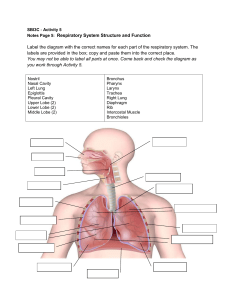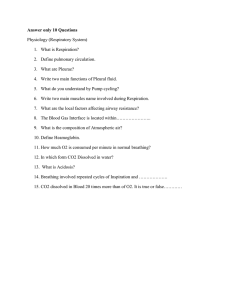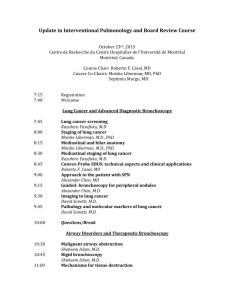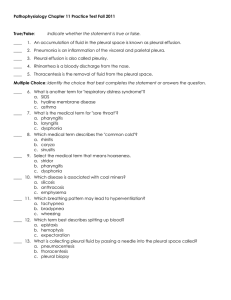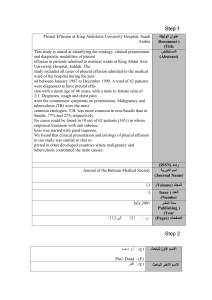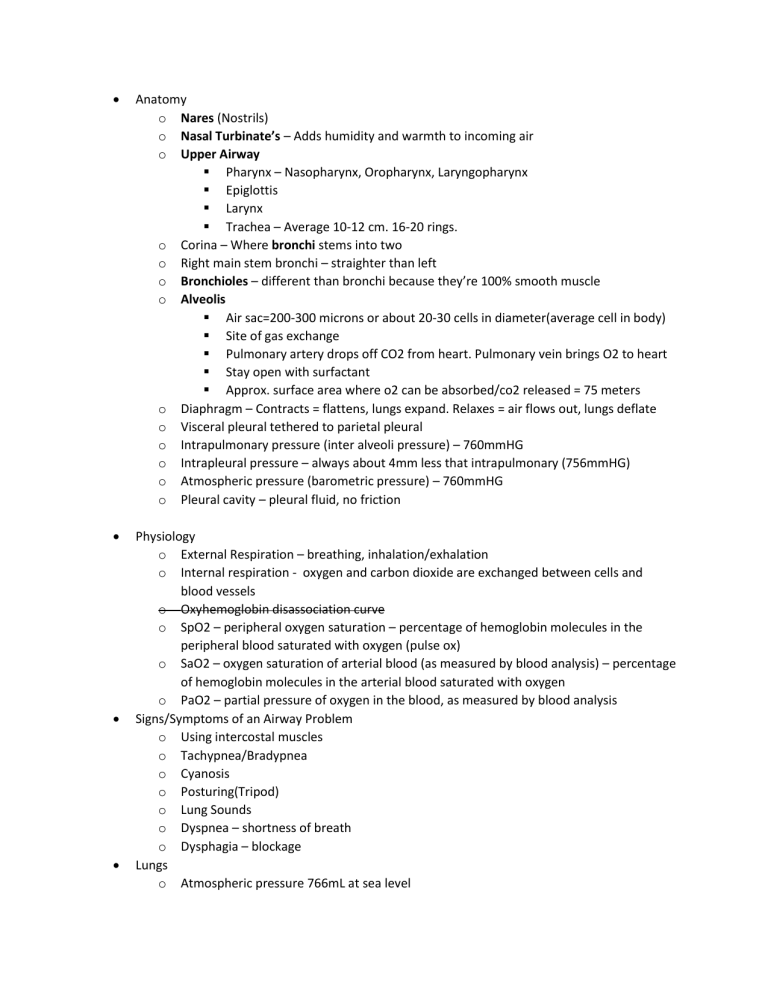
Anatomy o Nares (Nostrils) o Nasal Turbinate’s – Adds humidity and warmth to incoming air o Upper Airway Pharynx – Nasopharynx, Oropharynx, Laryngopharynx Epiglottis Larynx Trachea – Average 10-12 cm. 16-20 rings. o Corina – Where bronchi stems into two o Right main stem bronchi – straighter than left o Bronchioles – different than bronchi because they’re 100% smooth muscle o Alveolis Air sac=200-300 microns or about 20-30 cells in diameter(average cell in body) Site of gas exchange Pulmonary artery drops off CO2 from heart. Pulmonary vein brings O2 to heart Stay open with surfactant Approx. surface area where o2 can be absorbed/co2 released = 75 meters o Diaphragm – Contracts = flattens, lungs expand. Relaxes = air flows out, lungs deflate o Visceral pleural tethered to parietal pleural o Intrapulmonary pressure (inter alveoli pressure) – 760mmHG o Intrapleural pressure – always about 4mm less that intrapulmonary (756mmHG) o Atmospheric pressure (barometric pressure) – 760mmHG o Pleural cavity – pleural fluid, no friction Physiology o External Respiration – breathing, inhalation/exhalation o Internal respiration - oxygen and carbon dioxide are exchanged between cells and blood vessels o Oxyhemoglobin disassociation curve o SpO2 – peripheral oxygen saturation – percentage of hemoglobin molecules in the peripheral blood saturated with oxygen (pulse ox) o SaO2 – oxygen saturation of arterial blood (as measured by blood analysis) – percentage of hemoglobin molecules in the arterial blood saturated with oxygen o PaO2 – partial pressure of oxygen in the blood, as measured by blood analysis Signs/Symptoms of an Airway Problem o Using intercostal muscles o Tachypnea/Bradypnea o Cyanosis o Posturing(Tripod) o Lung Sounds o Dyspnea – shortness of breath o Dysphagia – blockage Lungs o Atmospheric pressure 766mL at sea level o o o o o Parietal pleural, pleural space, visceral pleural, lung Inspect Auscultate Wheezing – narrowing of airway Stridor – upper airway (above epiglottis), whistle sound Rales – thin sound (blood, plasma) “fine rhonchi” Rhonchi – thicker fluid “coarse rales” Cheyne-strokes: Abnormal/irregular breathing/hyperventilation Palpate Percuss - Melon Management o Jaw Thrust o Head tilt Chin lift o Monitoring o RR: 12-20/min o pH: 7.35-7.45 o EtCO2: 35-45 mmHg (5-6% CO2 with every exhale) Respiratory Opposite Metabolic Equal etCO2 increase, pH decrease HCO3 increase, pH increase o Pulse Ox Measures O2 saturation of hemoglobin 95% + o Vents Dislodged Obstruction Pneumothorax Equipment Adjuncts o NPA – use largest diameter that can be easily inserted (right nostril) o King LTD-S o Superglottic Device IGEL o CRIC Less than 1% of patients that need airway adjuncts survive
